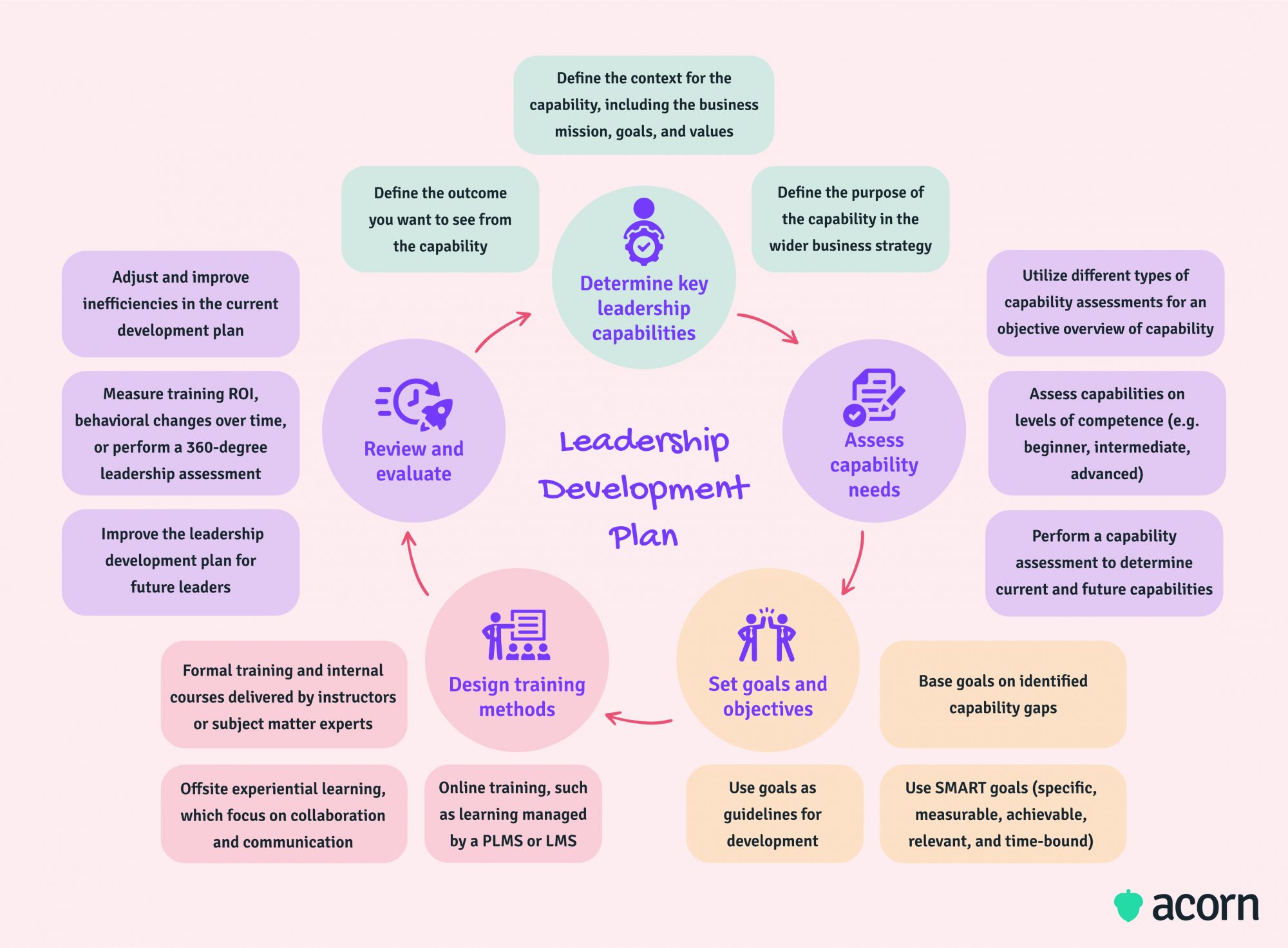Your Leadership Development Plan Template & How to Write One
Reading Time:

Lead the pack with the latest in strategic L&D every month— straight to your inbox.
SubscribeLooking for a step-by-step process for writing a leadership development plan?
Effective leadership is essential for all business continuity, so it goes without saying that all organisations need to prioritise leadership development. This is where a leadership development plan can help you foster leadership skills and qualities in your high-performing employees.
In this article, we’ll discuss the components of a good leadership development plan and how it ensures business success and secures your succession plans. We also have a leadership development plan template for you to download for free.
What is a leadership development plan?
A leadership development plan is a strategic framework that outlines the steps, activities and resources needed to gain and develop leadership capabilities within an organisation. It’s a personalised, structured, and long-term roadmap that helps individuals bridge the gap between their current capabilities and required leadership capabilities.
The importance of leadership development plans
In today’s competitive business environment, organisations that recognise the value of investing in their leaders gain a distinct advantage. Leadership development plans are crucial in unlocking leadership potential in individuals and paving the way for future business success.
- Operational continuity, or succession planning, is the process of preparing a talent pipeline to mitigate the risks of employee turnover inevitably creating vacant positions. An effective leadership development plan builds a proactive talent pipeline to ensure a consistent supply of future leaders and a smooth transition into their roles, reducing the impact on operational continuity.
- Professional development helps to boost job satisfaction and employee retention, with 94% of employees saying they were more likely to stay with a company if it invested in their learning and development. That’s a win-win: You can keep your most valuable employees, and you won’t have to spend as much (or as often) to cover the recruitment, onboarding and training of new hires.
- Increased performance and productivity. When leadership transitions are smooth, there is little to no dip in productivity from new leaders trying to get up to speed with their new role. Effective leaders are also able to inspire, motivate and guide their teams to ensure productivity continues.
- Effective leaders make better decisions. When you nurture leadership skills you create individuals who are confident in their leadership capabilities and are better able to make informed decisions, solve complex problems, and navigate challenges efficiently and in line with organisational priorities.
- Strong leadership influences organisational culture and the growth of both employees’ and their own careers, increasing employee engagement, creating continuous learning opportunities, and building a culture of continuous improvement. The idea is that they can champion learning to create incremental change towards organisational transformation.
The components of a leadership development plan
If you like, we’ve made a template that you can use as a basis for your own leadership development planning, which you can download below.
While leadership development plans should be tailored to the demands of your business and its specific goals, a successful leadership development plan is generally made up of the same key components.

1. Determine key leadership capabilities
The first step is to determine your key leadership capabilities. These are the knowledge, skills, tools, processes and behaviours that underpin effective leadership within your organisation, which means they need to be tailored to your business’s specific goals, objectives, and strategic priorities.
When determining your organisation’s crucial capabilities, it’s best to follow a three-step process of discovery.
- Define the context. This is the wider business context the capabilities will exist within. So, what are the goals, mission, and values of the organisation, and what role and value does leadership play?
- Define the purpose. What capabilities will help meet business goals, do you have the resources to sustain them, and is there demand for these capabilities in the market?
- Define the outcome. Each capability should be clearly named in terms of your desired outcomes. For example, openness to criticism is a key leadership capability as well as a desired outcome for your potential leaders.
If you’re having trouble identifying your crucial capabilities, we have a whole list of leadership capabilities for you to pick and choose from.
2. Assess capability needs
The next component of a personal leadership development plan is finding out your capability needs. This means performing a capability assessment to determine where your current leadership capabilities are, and how they compare to what you’ll need in the future. The “gap” between current and future capabilities is where leadership training comes into play; as you improve leadership skills and expertise, that gap will close.
Capability assessments evaluate how competent—or if you prefer, proficient—an individual is in a capability. Competency is visualised on a levelled scale, which generally follows a similar structure to:
- Beginner, where the capability still needs development
- Intermediate, where the capability is meeting expectations, but still has room for improvement
- Advanced, where the capability exceeds expectations, and the individual is an expert in the area.
Assessments can be self-assessed, manager-assessed, or even assessed by subject matter experts. Individuals have a pretty good idea of the limits of their own ability, but there is a chance they have blind spots in certain areas. That’s where manager assessments come in. Managers can be more objective overall, and they have a greater understand of business strategy and how required leadership capabilities play into that. On the other hand, assessments by subject matter experts are usually reserved for more specialist capability sets rather than general, in-the-weeds work.
3. Set goals and objectives
No development plan will get you very far without having set goals and objectives to aspire towards. Not only are they a north star to guide you towards the finish line, but they also provide a scale to track your progress with.
At this point, you know your key leadership capabilities, as well as your capability strengths, weaknesses, areas for improvements and potential blind spots. You can use this information to shape goals for your leadership development. So, if your capability assessments flagged your communication skills as needing development, then one of your leadership goals might be to improve communication between yourself and your team members.
There’s no “right” way to set goals (in fact, there are a few different methods) but the important thing here is that your leadership goals are realistic, measurable, and actionable. This way, you’ll have a basis to measure progress, as well as outcomes. So, using methods like SMART goals can be helpful here. In the end, you want to be able to prove the business impact and ROI of leadership development.
4. Design training methods
When you create a leadership development plan, you need to ensure you’re approaching leadership training and development the right way. The wrong approach can leave employees unengaged, and hinder knowledge retention and learning transfer. But with a training needs analysis, you can determine the best way to deliver learning.
The best way to train leaders will depend on the individual leader, the organisation, and the workforce as a whole. That being said, there are a few training methods to keep in mind.
- Online training, especially one delivered in a knowledge management system or performance learning management system (PLMS). This allows learning to be self-paced and contains all the relevant resources and knowledge leaders need in one central location.
- Offsite experiential learning generally has a focus on collaboration and communication skills (which good leaders should be proficient in) to build relationships and culture (which an impactful leader should be championing). The idea is to foster personal responsibility and emotional intelligence in the way leaders interact with others.
- Formal training seminars and internal courses delivered by an instructor equip leaders with the strategies, techniques and tactical skills needed in management and leadership roles. They can foster desired leadership qualities in individuals and help them to develop their leadership style.
The important thing to remember here is that even if you employ a one-time training course, leadership development must be ongoing. We’re talking informal coaching and mentoring, on-the-job training, and constant feedback to ensure that learning is retained, practiced, and continues to contribute to business success.
5. Review and evaluate
The crucial last step to a solid leadership development plan is to track progress. As we just said, you can’t set training once and expect it to keep giving. You need to monitor and review to:
- Adjust and improve inefficiencies in the current development plan
- Improve the leadership development plan for future leaders.
Continuously assessing both leadership capability and leadership performance gives you a greater understanding of the effectiveness of your leadership development plan. Like your leadership development strategy itself, there’s no one-size-fits-all process of evaluation. Instead, there are a few different methods you can use to measure the impact of leadership development training.
- Use a 360-leadership assessment by collecting feedback from all direct reports and peers to evaluate an individual’s leadership skills, knowledge and behaviours. It provides an objective and comprehensive view of a leader’s strengths, areas for improvement, and their potential blind spots.
- Observe behavioural changes over time. This is where you check whether knowledge learned is actually being applied in a leader’s day-to-day. Transformation doesn’t happen overnight, so it will be an ongoing process of review to see the incremental changes in behaviours and action over time. A PLMS can help you here. PLMSs are designed to link L&D experiences with business performance, proving the effectiveness of leadership development programs by demonstrating performance uptick.
- Measure the ROI of leadership training, including the business impacts created by leadership positions since undergoing a leadership development program.
The challenges of leadership development
Of course, leadership development plans aren’t without their challenges. We already mentioned how a lack of buy-in and support from the necessary managers and leaders can leave a development program dead in the water. Resistance to change is always a risk in implementing L&D.
There’s also the question of identifying which high-potential employees (HiPos) are candidates for leadership development. Ideally, your HiPos are the next generation of leadership for your business, but in reality, not all HiPos are cut out for (or want) leadership roles. Plus, like all assessments, performing capability assessments on your potential candidates can sap business resources from time, to budget, and to effort.
With leadership development and capability building being an ongoing process, you also need to consider if you have the resources to sustain leadership development over time. It’s a question best considered when identifying your key leadership capabilities, but circumstances can change down the line due to internal or external factors (which can hinder developing leadership). Lacking the resources is one of the greatest obstacles to capability development, whether it’s due to budget or capacity to deliver training.
Key takeaways
A leadership development plan is an essential step towards succession planning within your business, ensuring that your business has a healthy leadership pipeline to minimise disruptions to operational continuity. How you create leadership development plans will vary based on your organisation’s needs, but there are generally five components to include:
- Identify key leadership capabilities
- Get manager buy-in
- Assess capability needs
- Design training methods
- Review and evaluate.